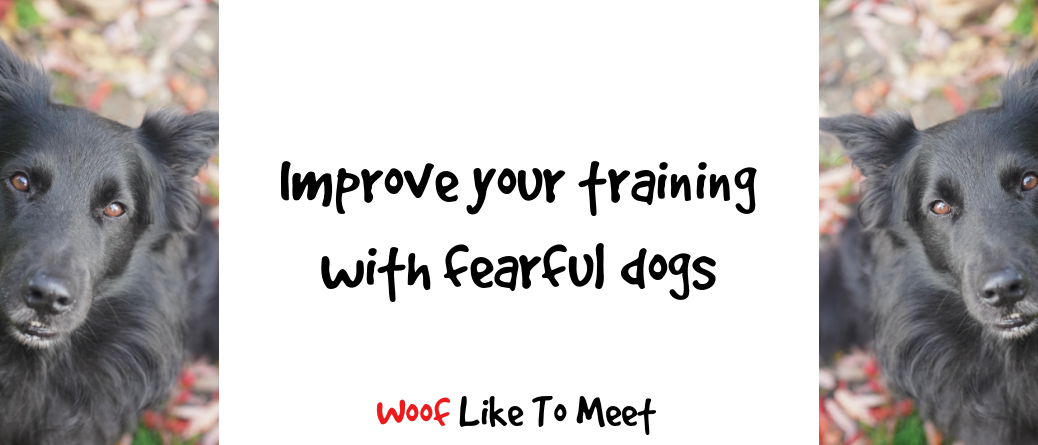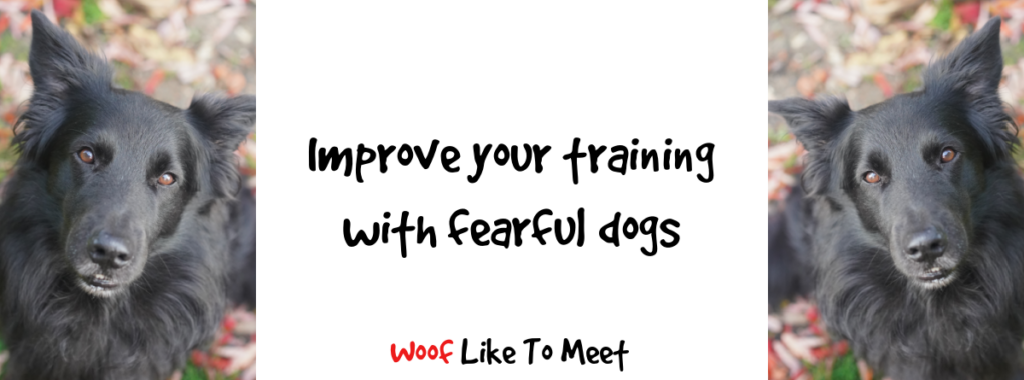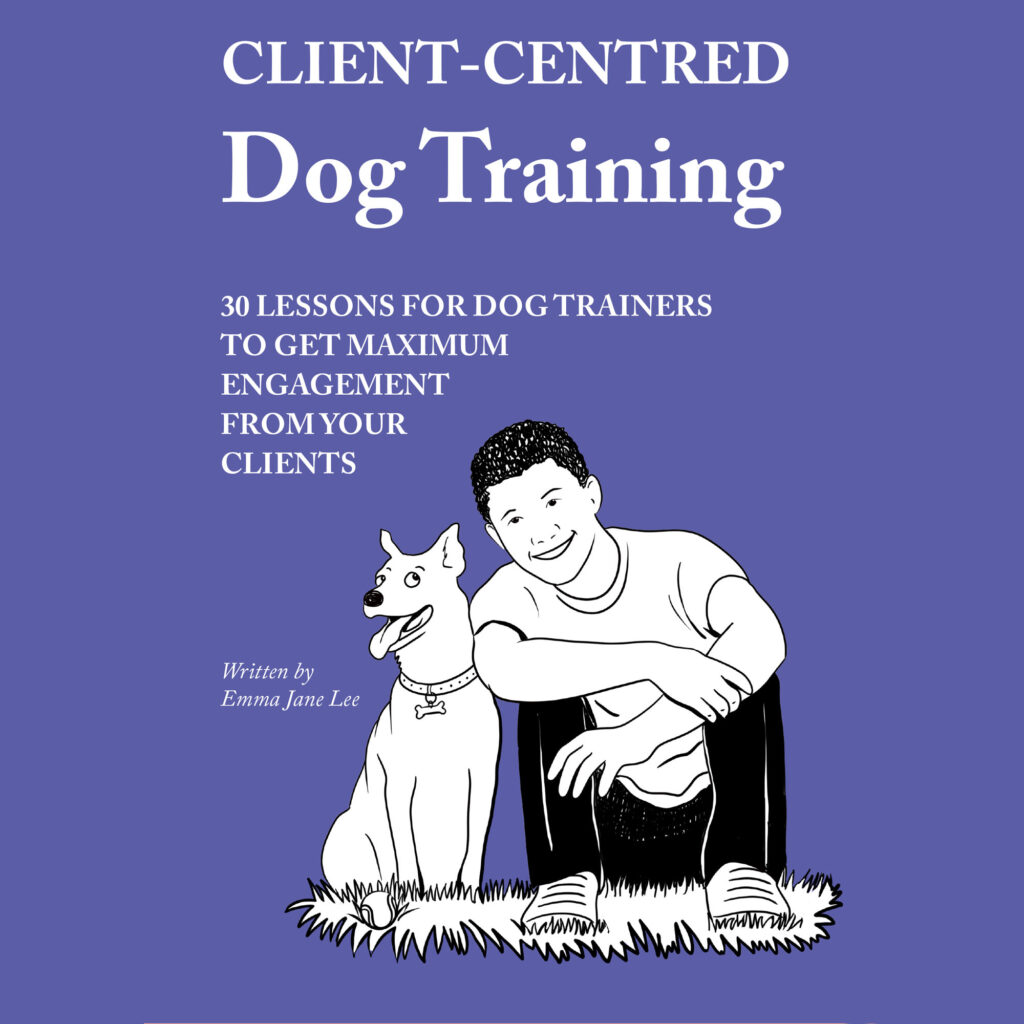Many of my clients have struggled in the past with training their fearful dog. Whether your dog is nervous on walks or whether they’re reactive, it can feel like you’re getting nowhere.
Part of the problem is that unless we deal with the emotions underpinning the behaviour, our training isn’t going to make much headway. It’s vital that we help our dogs feel better about the world in which they find themselves.
If you don’t, all you’re doing is trying to put training on the most shaky of foundations. You can read why here.
Essentially, if your dog doesn’t feel safe, the only thing that matters to them is safety. Food doesn’t matter. You don’t matter. Asking them to sit and face their fears doesn’t even register. If your dog feels like they can’t cope in the outside world, then nothing you can do will even register. It’s every dog for themselves.
And there you are, with your biscuits, hoping that teaching them to sit will make the slightest difference.
Sorry to break it to you, but you’re going to need a bit more than that.
Training can have miraculous results with fearful, anxious or nervous dogs. I wholeheartedly endorse Leslie McDevitt’s Pattern Games that you can find in Control Unleashed and I also thoroughly encourage you to follow Sarah Stremming of Cog Dog Radio. Both women are amazing trainers who use training to help dogs cope in the world in which they find themselves.
These methods work by creating a structure or ritual. That seems to work by predictability and routine. They seem to reassure the dog that, sure, we’re in a new environment… sure, scary things may be going on around us… but you and I, we have our thing. Having moved around madly these last four months, my dogs know that, as soon as the bed goes down, as soon as the blankets go down, this is where we are. This is home.
Wherever we do our routines, that’s our home. That kind of thing.
Many dog trainers can try to implement these strategies with fearful or nervous dogs with little success, however.
Partly, for me, that’s based on an over-reliance on training as the only way to make a difference to a dog. Dog trainers do what they know, and they feel less comfortable about other procedures, just as I would feel uncomfortable teaching all the bits and pieces for a Kennel Club award. I mean, I can, but I wouldn’t be as efficient.
How do we deal with the dog’s underlying emotions?
Here are ten ways that you can improve your dog’s progress and help them feel happier in the world.
#1 Medication or supplements
The first is to consider medication. While you may very well find some success with supplements and natural remedies, if you’ve got a dog who spends most of the day in a state of anxiety and then is hypervigilant outdoors, to the point that they won’t even pee outside, then this is a welfare issue, not a training issue. You may find some success with supplements, and certainly I’ve known dogs for whom they were effective, but if your dog is spending 16 hours a day in a state of nervous tension, trying to train them is more than likely to be completely inefficient.
If you are going to consult your vet, make sure you carefully document your dog’s behaviour. It can be very difficult for vets to see just how miserable your dog is. Make a diary, make videos and make sure you describe your dog’s behaviour objectively so that the vet can make the best decision.
#2 Lower anxiety in the home
If your dog is spending all hours of the day on high alert, they won’t be sleeping or resting properly. One of the easiest things to do is to reduce alert behaviours to noise outside the home and to add a little enrichment. I highly recommend Ali Bender and Emily Strong’s book Canine Enrichment for the Real World instead of feeding from bowls or forcing your dog to go out on walks that they clearly find distressing. Enrichment has other benefits: it focuses the dog’s attention on the good stuff and helps them block out the bad, even just for a little while.
If you’re aiming to add even just ten extra minutes a day, it can make a real difference. Anyone who suffers with anxiety will tell you that being able to immerse yourself in something – while it doesn’t treat the problem – as long as the ‘something’ doesn’t induce anxiety itself – can really help to give you a break from it. I always remember one time when I’d left my dogs with my dad. One of my dogs was newly epileptic. He was occasionally disoriented and I hadn’t heard from my dad all morning. I was in full on panic mode. However, I’d got a conference to deliver and that at least occupied me. By the time I’d delivered it, my dad had responded to my 53 messages and everything was fine. If I’d not been distracted by delivering a conference, I think I’d have driven 2000 miles back home just to check on them all. Doing stuff gives us a break from anxiety.
If your dog is alert and alarm barking all the time, you can also put this simple protocol into place.
#3 Make sure your dog is safe
Fearful dogs need to be safe. You can’t make them feel safe if they aren’t actually safe. Safety’s not some kind of illusion.
The first thing this means is stopping putting them in situations they can’t cope with, at least for a little while as you work with a trainer or behaviourist.
Because we often keep fearful dogs on the lead, it can run the risk that they don’t have a choice in where they go or what they do. If they weren’t on lead, they’d probably vote with their feet and go home. Having dogs in a crate or on a lead means they can’t escape from situations if they want to. As a result, it’s really important that we’re mindful of the fact our dogs can’t choose and therefore, we must choose venues and times for our walks that feel safer to our dogs. It’s all very well us thinking that our walks are safe, but it’s not our feelings that count.
This also means making sure your dog IS safe in the home, in the garden and on walks. Flat leads and comfortable harnesses are an absolute must.
#4 Make eating outside the home a habit
Many people assume that their dogs won’t eat outside because they’re in a panic or they’re not interested in food. Please check out this post and make sure you’re not just failing to teach your dog to eat in a variety of different places.
Since counterconditioning is very often done through pairing scary stuff with food, you do need a dog who’ll accept food outside the home. Eating is a habit. It’s a behaviour like anything else. When I think of how afraid Lidy is of strange people and being handled, or being at the vets and I know that she was taking paté from the vet, then I know that there is literally nowhere we can’t do a little work on her emotions.
If your dog won’t eat outside the home, however, it may not simply be that your dog is too afraid to eat (in which case, I’d say your dog was a really good candidate for #1 medication) but that your dog just doesn’t eat out of context. It’s a skill we need to practise, so rule out the common problems.
#5 Stop asking people to feed your dog
You can train very effectively without people giving food to your dog. Food is a positive thing. Scary people are a negative thing. When we give food to people to distribute to our fearful dogs in the hopes of teaching them that people are not so scary, it can really backfire. Your dog ends up bribed into the space of the scary human and when the food runs out, they’re often left in a state of ambivalence and ambiguity.
Keep the food yourself and use a training programme to help your dog that doesn’t involve this:
#6 Keep sessions short
Most of my clients have already tried to change their dog’s emotional state before they get to me. Most of them have tried to habituate their dog to the scary stuff by gently exposing them to the world outside.
Where I find most surprise from clients is that our first session might literally be 5-6 minutes long and only have 5-6 exposures to the scary stuff.
Pavlovian conditioning (pairing the scary stuff up with food) shouldn’t take hundreds of exposures for the dog to learn to associate the food with the scary stuff. If you follow #7 to #9 properly, the dog should make the association really quickly.
I often hear a lot of apologists for poor methodology from the dog training community. ‘Oh counterconditioning won’t work for me!’ they say, using cities or frequency of triggers as a reason.
I make no apologies for saying that I’ve counterconditioned dogs in one of France’s largest shelters where dogs have been surrounded by all the stuff they’re scared of and want to chase. You think your city is bad? Hello??!
Cars, wheelbarrows, hundreds of dogs barking, colonies of cats darting in and out, passers-by, would-be adopters, dogs coming in and out, vets on site, queues of people waiting for the vet with animals, well-wishers, volunteers, staff members, kennel stench, infernal noise, pound vans coming in and out, delivery vans arriving with food and kit, children wandering around, babies in pushchairs, then the wildness of national forest with teams of hunters, loose scenthounds, wild boar, deer, snakes, hedgehogs, badgers, squirrels…
If I can countercondition in a shelter environment in 5-6 trials, something is wrong with your methods, dude.
As Ginger Rogers reportedly said when asked how it was to dance with Fred Astaire, ‘Darling, I did everything he did… just backwards and in high heels.’
Working in a shelter is a bit like working backwards and in high heels. I don’t care where you’re working on your counterconditioning. It’s most likely much less stressful than a shelter and you can probably make better use of your environment. I’d love it if trainers stopped blaming their tools. I’m a very, very ordinary trainer and if I can make the pairing in 5-6 trials in 5-6 minutes in a shelter, I’m pretty sure anyone can do it. But you’ve got to be good at your craft.
That means doing less and making the pairing crystal clear. Choose a good set-up and make sure you’ve done your bit on #1 through to #5 and you’ll have a much better chance.
#7 Choose your time and venue carefully
If you want to be able to do #6 properly, you’ll need the right set-up. A set-up is just a carefully chosen area for where you’re going to make that pairing between food and scary stuff. It means working far enough away – sometimes 500m or so, but usually much less if you can organise or stage your venue carefully enough.
Sometimes that means using vistas as you’ll read in #8. It also means keeping counterconditioning sessions short and finishing on a win. Don’t keep going until the dog fails.
Another thing you can do is make sure you use time of day properly. Last week, I was staying at my mum’s. Turns out 5.30am in her neighbourhood is busier than 12.30pm. There were loads of people walking dogs before going to work, cats returning home from a night on the tiles, paperboys on bikes weaving in and out of driveways, people dropping in to the paper shop… it was mayhem. Here, at 5.30am, it’s me. Me and my dogs and a handful of cats. There’s a mass exodus of workers just before 6am and so there’s a few people moving about in high-vis jackets, and there’s cars, but there aren’t people walking shih tzus on flexi-leads, which is our worst nightmare. If I wait until 11am, then there are hundreds of crabby little shih tzus barking at everything they see.
So choose your time carefully.
At the shelter, I did make the most of this by doing sessions at 1.30pm when French people are mostly still in lunch mode. I didn’t do sessions on Saturday afternoon when 5-6 minute training sessions would be filled with 500 triggers. Take it easy on yourself and your dog and stop thinking you need to walk your dog when everybody else is too.
Get your set-up right and you can do almost anything.
#8 Go for vistas, not panoramas
If you’re forced by the universe to work closer to triggers than you’d like, being able to screen off much of the approach and retreat will help you keep exposures to triggers neat and precise. If the scary stuff is only in view for three seconds so you can open the food bar and close it in a very precise manner so the dog is absolutely clear on what’s causing food to rain from the sky, you’ll get much further.
Create a vista and watch counterconditioning become a cinch of a sprint rather than a torturous marathon. Work further away than you would normally think of doing and keep the dog under threshold if you can.
#9 Keep your clickers and marker words out of it for the beginning
Most people over-complicate counterconditioning. All you need is the scary stuff, the dog and something good to eat. You don’t need clickers or markers. If you’re using them, you’re doing something else entirely. That’s fine, but if you’re marking behaviour, you’re moving into operant training and that is something altogether different. I do use these, but not in my first three trials or so. Counterconditioning does not need a marker word or a clicker. Be silent and spend the time watching your dog, not adding more things in for them to cope with. Your voice gets in the way of them learning to pair up the scary stuff with the good stuff. It’s just noise. Literally.
You don’t need to cue the behaviour either – at least, not until later.
Keep your voice to yourself. Go zen. Be silent.
#10 Keep the dog moving
I will never understand why people stop with the dog to countercondition. All you’re doing is giving the dog a massive, massive cue that scary stuff will start. You’re telling them to be on the lookout.
Being still is the absolute opposite of what we need.
I know why – you might miss the triggers passing by. Standing still, even if you don’t ask for a sit, means not missing the trigger.
But so many times I see trainers making it harder for themselves, it’s because they’ve asked for a static behaviour. I can’t understand it. You might as well get a great big sign out that says to the dog, ‘The show’s about to start, buddy!’
Your standing still can be the biggest cue that triggers anxiety or fear. Worse, asking them for a sit and you’re not only telling them that zombies are about to appear, you’re asking them to sit through it. Not so much a show as a living, walking nightmare on legs.
Imagine if I did that with a human person. You know… You’ve got a fear of bats or something. I take you into a room, I ask you to sit down, I bring a load of bats in and then I ask if you’d like some cake.
Next time I take you to that room, I ask you to sit down… well, you’re going to know bats are next on the agenda. Do you think my cake will work?
There’s a very strong argument that cues can actually make aversive experiences less bad. Surprise dentistry or appearance of bats, spiders or snakes can actually be more scary than knowing that you’ve just got to get through it. Knowing when and where they appear can make it less scary.
So there’s that.
But there’s also a lot of evidence that when animals have learned to be afraid of things, often the cue itself can be enough to generate fear that’s as bad even when there’s none of the scary stuff. In laboratory experiments where scientists have deliberately created fear in dogs, they sometimes put a tone before shocking the animal. Even in experiments where there was no shock for hundreds of times, the animal acted as scared of the tone as they were of the shock. I’m not engaging in some melodramatic exaggeration for rhetorical effect, I literally mean hundreds of times. Three scientists in the 1960s paired a tone up with footshock 10 times. Then they just played the tone. The dogs in the experiment acted as fearfully as if they’d actually been shocked. That behaviour lasted hundreds of repeats where the dogs were just presented with the tone and not the shock.
In other words, stop telling your dog there’s going to be scary stuff. You’re just making the way you announce it – usually stillness – into a giant cue that scary stuff will happen.
Obviously, the best way to change your dog’s emotional response to scary stuff is to see a good trainer or behaviourist – one who does #1 to #10 without even thinking about it. But it’s more than feasible for everybody if you’re clued up on what you’re doing. Quite frankly, if you can follow the rules, you’re probably going to be 99% more effective anyway.
Don’t overlook the simplicity and effectiveness of counterconditioning to change your dog’s underlying emotions about things. It’s not hard. It doesn’t take months of work. It shouldn’t be complex or challenging… you’re literally letting your dog see the scary stuff and then giving them food. That’s all there is to it. Maybe that’s why I like it so much. It’s so simple.
But you do need to do some other stuff alongside it to make the pairing of scary stuff and food clear to your dog. Most dogs I work with, shelter or not, get it by the third repetition on the first day. Two minutes. They’re savvy.
That’s not an accident though. It’s because I know how to maximise my efficiency. I say often that I’m a lazy trainer. I really am. But that’s because I know that giving my dog a treat at the right moment on our daily walk, and doing that five times at the opportune moment, is a hell of a lot easier than spending eight months making no progress whatsoever. It’s not just easier, it’s more efficient.
Why do it the hard way and make life more difficult for both you and your dog? You’re adding months if not years on to your training plan and it’s bound to cause you nothing but frustration and disappointment. Be simple, be clear and be precise and you’ll be getting that head snap when you see the scary stuff within three or four trials.
Ultimately, as neuroscientist Jaak Panksepp reminds us, being aggressive or being fearful are not nice ways to feel. If we’re offered the choice between feeling nice and feeling rubbish, we’ll take feeling nice. Our bodies are desperate to feel safe. When we work with that knowledge and we keep our training clean and efficient, our dogs very quickly learn to do the stuff that feels nice and avoid feeling afraid.
Next week, I’ll look at ten ways you can improve your training with dogs who like to chase livestock, pets, wildlife, machinery or people.
I also have a book out! It’s over at Amazon. It’s pretty good, if you’re a dog trainer looking to get more out of your work. I would say that, wouldn’t I?!




